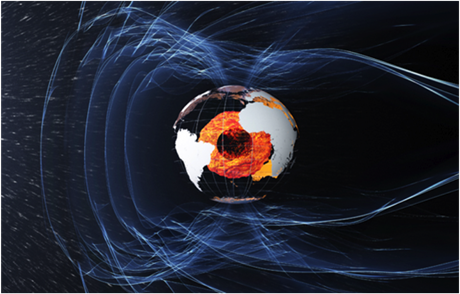Geomagnetic data
Here can be found not only the geomagnetic observations from the Coimbra station (COI), but also other observables of interest for the monitoring of space weather conditions.
|
Geomagnetic storms result from variations in the solar wind (many resulting from coronal mass ejections)
resulting in major changes in the currents, plasmas, and fields in Earth’s magnetosphere.
In addition to the occurrence of auroas, the inpact of these events can include disruptions
in global navigation systems and power grids.
Magnetic field variations are constaly measured by observatories across the world, usually in one
second to one minute intervals.
|
 |
Earth's magnetosphere.
(source: DTU) |
|
Global geomagnetic indices such as the disturbance storm time (Dst) and
and the planetary K index provide information about the disturbance level of the geomagnetic field on a global
scale. These are computed using the variations of the magnetic field observed by several magnetometers located
around the world on an hourly/tri-hourly basis.
These observations are corrected of long term and normal diurnal variations of the magnetic field.
The later one is computed taking into account the most geomagnetic quiet days defined internationally
(often the 5 most quiet days of the previous month).
A Dst index of -50 or deeper or Kp indices greater or equal to 5 indicate a storm-level disturbances.
It is also possible to compute local geomagnetic indices
concerning the local magnetic field conditions, yet in this case the
local daily variation has to removed first.
 |
Magnetic field reference systems
(source: USGS) |
|
The magnetic field is vectorial quantity, i.e. it has magnitude and direction. In a three dimensional world
is described by three quantities which vary depending on the coordinate system used.
In the case of the observations from Coimbra's geomagnetic station
(IAGA code: COI) we present the magnetic field's intensity tangential to Earth's surface (i.e. horizontal - H);
the downward component of the field (Z) and the angle btween the horizontal component of the magnetic field and
the geographic north pole (or magnetic declination - D).
Likewise can be indicated the inclination of the magnetic field in respect to the vertical direction (I).
Instead of the H and D components of we can use the horizontal component's intensity towards the north pole (X)
and towards the East (X).
Consequently the total magnitude of the magnetic field F corresponds to √(X²+Y²+Z²) or √(H²+Z²).
|
|
Geomagnetically induced currents (GIC) are quasi-direct currents induced
on electrical conductors by strong variations of Earth's magnetic field that occur during strong geomagnetic storms.
These can severely disrupt the electrical power grid (particularly by damaging power transformers) as in
the 1989 event.
The study of geomagnetically induced
currents in northeastern Spain's power grid, shows the local variation of the geomagnetic field's
importance in assessing the impact of GICs on the national power grid.
|
 |
Power lines.
(source: Wikipedia) |
|
Data available:





